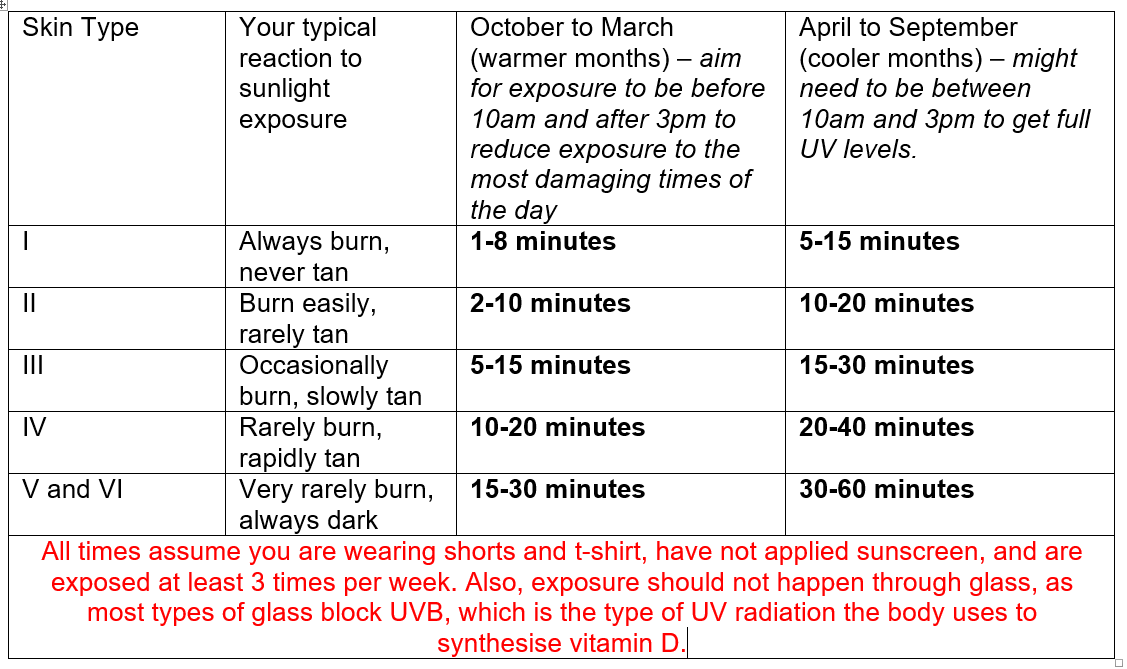
It’s summer!
In simple terms that means it is warm/hot and the sun is out regularly.
It also means that people wear less clothes and expose themselves to the sun.
What constitutes healthy sun exposure is a little difficult to define. Too much exposure and you get burnt and increase your risk of developing skin cancer. Too little and you run the risk of vitamin D deficiency.
What is vitamin D?
Vitamin D is one of the many nutrients our body needs to stay healthy. It plays a number of roles in the body including keeping bones strong and healthy, improving muscle function, the functioning of the heart and lungs, brain development and strengthening our immune system.
Unlike other vitamins, we don’t get most of our vitamin D from our food. Instead, the body makes vitamin D when your skin is exposed to sunlight (UV radiation). Thus our level of sun exposure influences our levels of vitamin D. Vitamin D can also be obtained through supplementation.
A lack of vitamin D has been linked to a number of health conditions: cancer, asthma, type-II diabetes, high blood pressure, depression, Alzheimer’s and autoimmune diseases like multiple sclerosis, Crohn’s and type-I diabetes. It should be noted however that this is not evidence that vitamin D can be used to treat these conditions.
Research into vitamin D has been exploding over the last few years. Expect to read a lot more about vitamin D in the years to come.
What is the right amount of sun exposure?
The main thing I wanted to address in this blog post was how much sun exposure you need on a daily basis to give you the best chances of having appropriate, healthy levels of vitamin D, but also limit the risk of skin damage.
It is not a simple question to answer because UV levels fluctuate depending on the time of the year, and there are individual differences in how effectively different people can produce vitamin D. For example, people with naturally very dark skin, who have higher levels of the pigment melanin in their skin produce less vitamin D from sun exposure, because melanin acts as a filter for UV radiation.
In the table below, I have tried to pull together some conservative estimates of the exposure time required based on time of year (and hence UV radiation levels) and skin type. Skin types I and II are typically Caucasian people like myself with pale white skin. Skin types IV, V or VI are more likely to be people of Asian or African genetic backgrounds who have darker skin.
I have pulled this information together by combining information from the following sources:
- https://www.betterhealth.vic.gov.au/health/healthyliving/vitamin-d
- http://www.gbhealthwatch.com/Trait-Sun-Exposure.php
- https://wiki.cancer.org.au/skincancerstats/UV_radiation
- https://www.osteoporosis.org.au/vitamin-d
You’ll note that the exposure times are based on a number of assumptions: wearing shorts and t-shirt, not wearing sunscreen, getting exposure at least 3 times per week, and not behind glass (e.g. driving, or sitting in office).
You’ll also note that during the warmer months, the suggestion is to get the exposure during the less intense times of the day (before 10am and after 3pm). During the cooler months, you might need to put the exposure between 10am and 3pm to get best UV exposure.

Any more than the exposure times listed and there is risk of overexposure and skin damage.
Am I at risk of a vitamin D deficiency?
In Australia, it is estimated that around 23% of adults have a vitamin D deficiency, so it is not an insignificant issue.
Those at higher risk include:
- people with naturally very dark skin
- people with little or no sunshine exposure
- older adults
- people who wear covering clothing for religious or cultural reasons
- people who avoid sun exposure for cosmetic or health reasons
- people at high risk of skin cancer who avoid sun for that reason
- people hospitalised or institutionalised for long periods
- people with a disability or chronic disease
- people in occupations with little sun exposure (e.g. health bloggers like me :))
- people with medical conditions or medications affecting vitamin D metabolism
- obesity
- end-stage liver disease
- kidney disease
- conditions that cause fat malabsorption (e.g cystic fibrosis, coeliac disease, inflammatory bowel disease)
- use drugs that increase breakdown of vitamin D (e.g. rifampicin, some anti-convulsants)
If you are concerned about your vitamin D levels, speak to your doctor.
Want to comment on this article, or ask me a question about the health and well-being services available to you as a student? Feel free to comment below, abuse me on Twitter (@Dr_Furber), contact me on Skype (search for ‘eMental Health Project Officer Gareth’), or email me (gareth.furber@flinders.edu.au)

